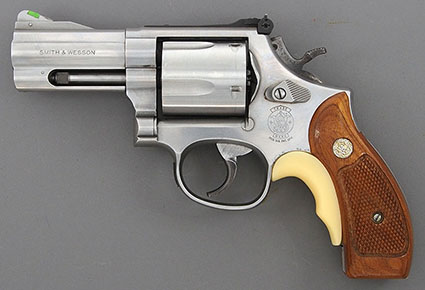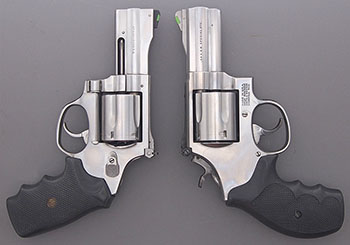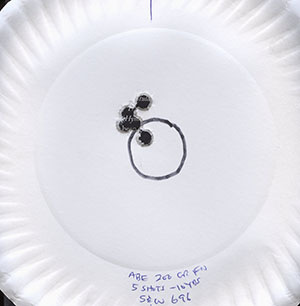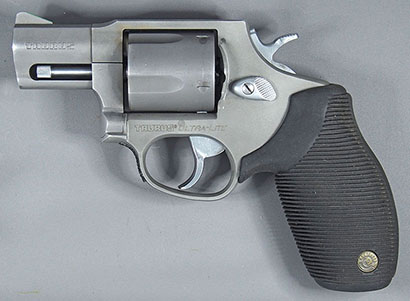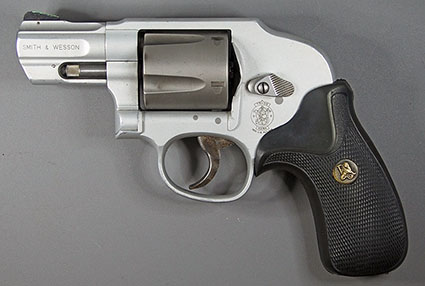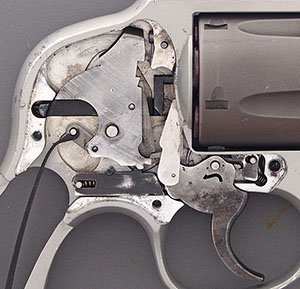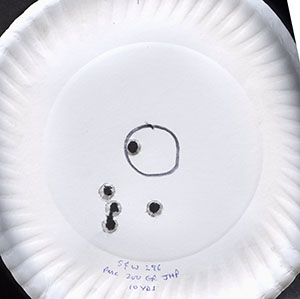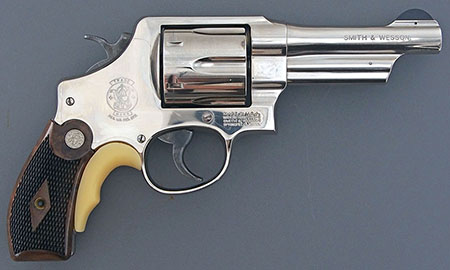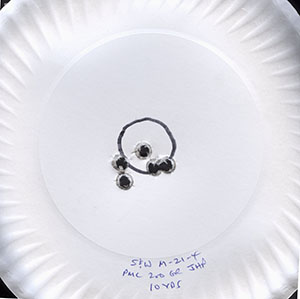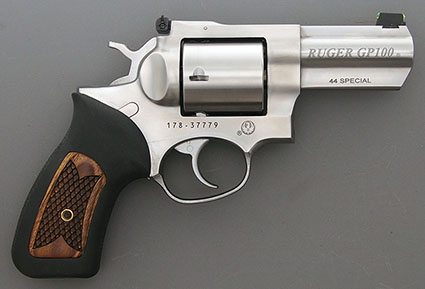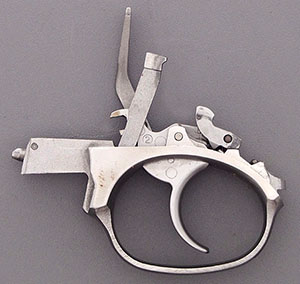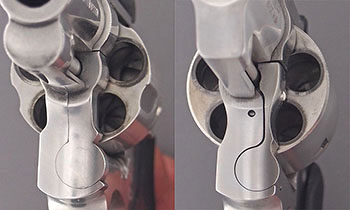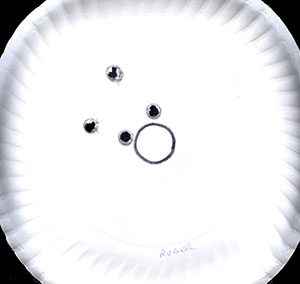 |
|||
|
.44 Special Revolvers Continued
The factory trigger on the 696 was about 12.5 pounds double action and 5 pounds single. I polished all the internal parts and installed a set of reduced power springs from Jerry Miculek. (Miculek also sells the best video I have ever found on how to do a trigger job on a Smith & Wesson revolver.) Now the double action is ten pounds and the single is two. In my opinion, two pounds is too light for a single action trigger but I shoot this revolver double action only and at some point I may bob the hammer. The modern Smith & Wesson revolvers have a hammer with a shorter arc of travel than the earlier guns, though I am uncertain as to when this change was made. It is difficult to measure, but I tried, and I believe the hammer travel was reduced by about 15 degrees of arc, which is significant. This means the hammer does not have to go as far back during double action shooting. It gives a very different feel to the double action and makes the gun faster to fire.
One last note: My accuracy tests are done single action from a bench rest. The rubber grips seemed to fit my hands just fine in all my preliminary testing. But when I began doing instinctive shooting drills I discovered I was not as accurate with this gun as with other guns, particularly my S&W Model 21-4. I realized that the finger grooves, or possibly the overall shape of the grips, was preventing me from gripping the gun high enough for instinctive shooting. I happened to have a pair of standard L-frame Smith & Wesson wooden grips that I had taken off a gun I no longer own and I put them on the 696 and added a grip adapter: problem solved.
The Taurus Model 445 appeared in 1997 and was made until 2003. It was reissued again in 2011. It seems to have replaced Taurus’ previous offering in .44 Special, the Model 441 (with adjustable sight), and the Model 431 (with fixed sight), which are almost twice as heavy as the 445. The gun is marked “Taurus Ultra-Lite” and it has an alloy frame,
Internally, the 445 is somewhat similar to a Smith & Wesson but it does not have a rebound slide, though it has a trigger return spring in the same position. The Taurus does not need a rebound slide because, like a Ruger, it utilizes a transfer bar so the hammer never engages the firing pin directly. The double action trigger pull was over 15 pounds when I got the 445 but I did some polishing of interior parts and put a Wolff reduced power spring set in it, giving it a 12 pound double-action trigger pull. The accuracy is reasonable for a two inch barrel but recoil with this gun is punishing despite the very soft ribbed rubber grips. It is two ounces heavier than the Smith & Wesson Model 296, described below, yet has more apparent felt recoil.
The 296 quickly became a favorite concealed carry gun. The trigger was about 13 pounds when I got it,
One interesting point about the 296 is that it does not have a hammer block. As with other Smith & Wesson revolvers with internal hammers, since the hammer is fully enclosed the rebound slide is the only safety mechanism needed.
A quick history is necessary in order to catch us up on the Smith & Wesson line of .44 Special revolvers. The Second Model Hand Ejector came out in 1915 and continued in production until 1926. In 1926 the Third Model Hand Ejector appeared with an integral underlug that looked like that of the First Model but without the third locking lug—this was the first Smith & Wesson .44 Special with a hammer block, though the first design for a hammer block was patented in 1910. The hammer block works off the rebound slide, blocking the hammer from hitting the firing pin unless the trigger is all the way to the rear. This is an additional safety mechanism, in case the gun should be dropped and land on the hammer. World War II put an end to .44 Special productio, but it started again in 1946 with the introduction of the Fourth Model Hand Ejector, with a fixed rear sight, which for a time continued to be known as the Model 1926. In 1950 a Target Model with an adjustable rear sight appeared. Over the next few years the nomenclature evolved, so the Fourth Model with the adjustable sight became the “Model 1950 .44 Target” and the Fourth Model with the fixed sight became the “Model 1950 .44 Military.” Then in 1967 the names changed again. The “Model 1950 .44 Target” became the Model 24, and the “Model 1950 .44 Military” became the Model 21. All these guns continued to have five screws until 1955 when the upper sideplate screw was eliminated. The screw in front of the trigger guard, along with its spring and plunger, was eliminated in 1961. In August of 2004 the first round butt N frame .44 was produced as the Model 21-4. This is a CNC machined three-screw gun with an internal locking device and a four-inch barrel. A number were produced as the Thunder Ranch Special but I have been unable to determine exactly how many. According to the Standard Catalog of Smith & Wesson, only 225 were made with an electroless nickel finish in 2006. I found the Model 21-4 in electroless nickel on consignment in a local gun shop. I knew nothing about it and was simply attracted by its aesthetics. It looked very impressive in the show case. I tried to talk the owner down a bit, but he held firm and I ended up buying the gun anyway. This was my first .44 other than a Charter Arms Bulldog. The round butt grip is far too small for any man with normal to large hands. It might fit a woman’s hand, if she had the strength to hold such a big revolver. I bought some oversize grips for it but they never fit my hands properly either and I eventually put the original grips back on and added a grip adapter from BK Grips. Once I started shooting it regularly, I discovered that the 21-4 is an extremely accurate gun with a superb trigger. There is a high berm at our gun range at about 25 yards from the firing line and it is easy to hit clays from 25 yards with this gun, even double action. It is very rewarding to have a gun that shoots where you point it every time.
For years I never thought of carrying this gun, thinking it was just too heavy. But after I bought a Model 296 and began to carry it in a belly band holster, I wondered if it might be possible to carry the 21-4 and some of my other heavy .44s the same way. I bought a four-inch wide belly band holster and it works great at least for winter carry in Texas. So far the electroless nickel finish is holding up very well and I have never had any trouble with the internal lock; I wish it weren’t there, but it appears to be harmless. I have never had the key.
Ruger began
The double action trigger pull on my GP-100 was a stiff 13 pounds out of the box and the single action was a rough 4.5 pounds. I had never worked on the action of a Ruger before but I decided it was time to learn. There are some excellent videos available on YouTube and replacement springs are available from several sources. The Ruger does not have a sideplate like Smith & Wesson and Colt revolvers but the entire lockwork is attached to the trigger guard assembly and is removable as a unit. The lockwork is very much like that of a Smith & Wesson,
I am not an expert on the production methods of the Ruger company but my understanding is that many components are made of cast steel, which is then machined to necessary tolerances. Compared to other revolvers, there is a noticeable gap between the crane and the frame; fortunately the crane is locked in place by a blade at the front which fits into a slot cut in the frame, providing precise positioning, but there is a certain cognitive dissonance when one sees the crane fitment for the first time. The first several times I shot the gun, the pin holding the rear sight worked loose--an application of some red Loctite resolved the problem.
|
|||||||||||||||||||||||||||||||||||||||||||||||||||||||||||||||||||||||||||||||||||||||||||||||||||||||||||||||||||||||||||||||||||||||||||||||||||||||||||||||||||||||||||||||||||||||||||||||||||||||||||||||||||||||||||||||||||||||||||||||||||||||
|
|||||||||||||||||||||||||||||||||||||||||||||
|
|
Copyright 2020 by Ed Buffaloe. All rights reserved. |
||||||||
|
|
||||||||
